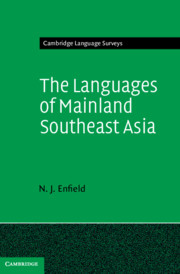Book contents
- The Languages of Mainland Southeast Asia
- Cambridge Language Surveys
- THE LANGUAGES OF MAINLAND SOUTHEAST ASIA
- Copyright page
- Contents
- Figures
- Maps
- Tables
- Preface
- Acknowledgements
- Note on the nature and organization of the book
- Abbreviations
- 1 Context
- 2 Language Histories and Classifications
- 3 Typological Overview
- 4 Phonological Systems
- 5 Word Formation
- 6 Reference and Nominal Syntax
- 7 Predication and Clausal Syntax
- Postface
- References
- Author Index
- Language Index
- Subject Index
5 - Word Formation
Published online by Cambridge University Press: 22 March 2021
- The Languages of Mainland Southeast Asia
- Cambridge Language Surveys
- THE LANGUAGES OF MAINLAND SOUTHEAST ASIA
- Copyright page
- Contents
- Figures
- Maps
- Tables
- Preface
- Acknowledgements
- Note on the nature and organization of the book
- Abbreviations
- 1 Context
- 2 Language Histories and Classifications
- 3 Typological Overview
- 4 Phonological Systems
- 5 Word Formation
- 6 Reference and Nominal Syntax
- 7 Predication and Clausal Syntax
- Postface
- References
- Author Index
- Language Index
- Subject Index
Summary
This chapter gives an introductory overview of the strategies for forming words in the languages of mainland Southeast Asia. The chapter begins with a discussion of the form class distinctions that are found, including the categories of noun, verb, adjective, adposition, and adverb. Of the various processes for forming words, the chapter focuses on compounding and reduplication, which are relied upon widely in languages of the area, and affixation, which is a speciality of Austroasiatic languages in particular. The chapter features a section on the uses of tone in word formation, a feature of Hmong-Mien languages. Psycho-collocations are discussed: an area-wide form of compounding involving the mention of body parts to denote emotional and psychological states.
Keywords
- Type
- Chapter
- Information
- The Languages of Mainland Southeast Asia , pp. 209 - 256Publisher: Cambridge University PressPrint publication year: 2021

